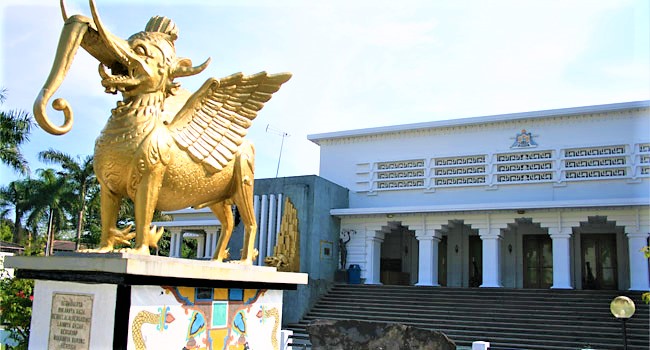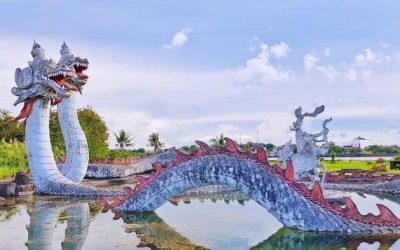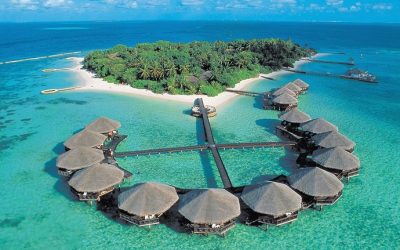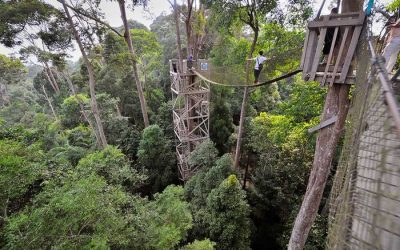Home / Batik Regions – Central Indonesia – Kalimantan Island – East Kalimantan / Museum of Mulawarman
Cultural Destination
Embrace the spirit of the place!
Museum of Mulawarman
Museum of Mulawarman, Tenggarong City (photo: Diksi)
Museum of Mulawarman
Do you want to explore Dayak culture across centuries? The Mulawarman Museum in Tenggarong city is the right museum to visit. This museum has one of the most complete collections in Indonesia. There is also a duplicate of the Lembuswana mythological statue, which is a symbol of the kingdom of Kutai Kartanegara. This museum was built by adopting the traditional architecture of the Dayak tribe in Kutai. Prepare to be amazed!
Tourist Attractions in East Kalimantan
Kumala Island of Mahakam River
Do you want to fully experience the Lembuswana mythology in Kutai?
Derawan Island – Marine Conservation Site
Derawan is one of the national marine conservation sites where marine wonderful animals such as shark whales,
Bangkirai Hill Natural Conservation Site
If you have always dreamt to do a little adrenaline outdoor activities,
East Kalimantan
Batik Motifs
Hiu Taliyasan
Indonesia is also home to the world’s largest fish, the whale shark (Rhincodon typus). Hiu Taliyasan refers to
Kuntul Perak
Kuntul Perak refers to Egret Silver Bird. This bird is a Kalimantan endemic animal that becomes the
Tengkawang Ampiek
With its many advantages, the Dayaks use this leaf in ritual ceremonies. This plant is a symbol of
Discover
Indonesian
Batik
Motifs
Taiganja
Taiganja is a precious gold pendant that shows the social status of the Kaili family. It is
Gurdo Solo
Gurdo or garuda bird is the mount of the Indian god Vishnu. As the Sun Bird,
Gonggong Beruntun
This motif illustrates that a person should maintain a positive attitude and
Daun Lada Hitam
The black pepper motif represents the main commodity of Bangka Belitung
Karawo Pinang
Pinang refers to the Palm areca tree. This motif is considered as the original
Pucuk Rebung Riau
Pucuk Rebung symbolizes heart determination in achieving goals, good luck, and
Buketan Bali
The Balinese bouquet (Buketan Bali) is a floral arrangement and the name is
Sido Mulyo
Sidomulyo is one of the classical motifs, which is specifically used for the bride’s costume in
Ake Patra
Ake is related to the divinity and the composition of the universe. It is a symbol of
La Galigo
La Galigo is a literary work of the Buginese Epic that has 300 thousand epic lines. It is considered even
Bale Lumbu
This motif signifies the welfare of the ancient Sasak society. Bale also symbolizes the
Angsa Duo
According to legend, the Angso duo batik motif is a pair of swans that are believed to have led Princess
Lipaq Sabe
Lipaq Saqbe contains a simple geometric classical motif with various flower decorations. This textile is
Bultiya
The word ‘Bultiya’ is an acronym of the three major tribes in North Kalimantan, namely
Mahkota Siger
Siger is the crown of a noblewoman in ancient time. It is a symbol of femininity, strength, and
Cengkeh
The clove flower motif is the main commodity of the Tolitoli Regency. This motif represents
Karawo Mahkuta
Mahkuta refers to Gorontalo’s traditional crown. It represents noble characters of
Parang Seling
Parang Seling or “alternating daggers” is a royal batik motif. It is a feminine variant of
Tikar Natuna
The Tikar Natuna motif is adapted from the traditional making of pandanus mats in
Tifa Totobuang
The batik motifs illustrate Maluku’s traditional music instrument called
Singayaksa
The Singayaksa motif comes from the name of a place where Sultan Hasanuddin used to
Lontara
The Lontara script itself is a typical ancient script of Bugis and Makassar communities. History records that
Daun Sirih
This motif illustrates betel leaves that are used by Lombok communities as traditional
Hiu Taliyasan
Indonesia is also home to the world’s largest fish, the whale shark (Rhincodon typus). Hiu Taliyasan refers to
Srimanganti
The name of the Srimanganti motif is derived from Palace’s hallway that connects to
Wakatobi
It symbolizes the coastal beauty of the Wakatobi island and the symbol of Patra symbolizes
Bomba Mawar
This motif means sacred love for family, kingdom, and God; It also illustrates
Kerawang Tegak Aceh
The Vertical Upright (Kerawang Tegak) Motif symbolizes a person who has a strong
Daun Simpor
This motif is inspired by the Simpor plant (Dillenia Suffruticosa) which is a typical
Gumin Tambun
Based on Hindu mythology, this motif symbolizes lucks, abundant wealth, and
Kaganga Tanah Rejang
If Batik Besurek combines Arabic calligraphy motifs, then the Kaganga batik takes
Ukir Sentani
The Ukir motif is a batik motif that is inspired by various traditional Sentani wood carvings
Tengkawang Ampiek
With its many advantages, the Dayaks use this leaf in ritual ceremonies. This plant is a symbol of
Salakanagara
Salakanagara batik motif illustrates the first kingdom in the Betawi land
Besurek Rembulan
This batik illustrates praise for God who created the wonderful universe
Tangerang Herang
Tangerang Herang motif is a symbol of Tangerang city. The Tangerang Herang batik motif consists of
Gedhog Kembang Waluh
a combination of Javanese cultural motif of the Majapahit kingdom (XII-XIV century) with
Prada Papua
The word “Prada” in the Javanese-Indonesian dialect means a batik textile that
Manguni Minahasa
Manguni is identified as the symbol of the Minahasa people. Manguni is known as a
Tabir Tanjung
Tanjung flower is a type of Cherry tree flower, which is commonly found in
Leuit Sijimat
This motif reflects the daily activities of the Baduy tribe in Banten. The main ornaments of batik motif consist of:
Merak Ngeram
The hatching peacock motif has a very deep meaning which refers to the sacrifice and
Teguh Bersatu
This batik motif shows the strength of the people of Kupang. It also represents a sense of
Raja Ampat
Raja Ampat motif represents the marine life at Raja Ampat archipelago in
Ikan tambal
The word “Ikan” refers to fish. The philosophical meaning of Ikan Tambal means is
Sekomandi
Its philosophical meaning is the eternal union which refers to a saying “until death do us part”
Bintik Tujuh
The Bintik Tujuh (Seven Dots) motif has 7 white spots and green color gradation as
Gamolan
This motif illustrates Gamolan, a bamboo musical instrument of Lampung that is
Dayak Kamang
Kamang motif is generally found in the Dayak tribe shield because it is believed to
Paqbarre Allo
The word “Barre” means round and “Allo” means the sunlight. This motif is interpreted as
Desa Na Tolu
The Desa Na Tolu characteristic pattern symbolizes the Batak philosophy of existence and
Pohon Hayat (Tree of Life)
The Batik motifs in Lampung are dominated by the acculturation of Buddhist and
Enggang Dayak
Local people beliefs that hornbills are an incarnation of the Commander of the Birds. It has supernatural
Gonggong Siput
Gonggong (Strombus Turturella) is one type of sea snail found around
Pala Salawaku
This motif illustrates the unique weapons of the Maluku region, namely
Rangkiang
The word “Rangkiang” refers to the rice granary in the Minangkabau language. It symbolizes
Gigi Haruan Lidi
The Gigi Haruan Lidi motif is taken from the name of the cork fish and is a symbol of
Kasih Tak Sampai
‘Kasih Tak Sampai’ is an idiom in the Indonesian language which refers to
Gentala Arasy
Built as high as 80 meters, the tower also highlights the historical side of
Parang Rusak
Another meaning behind this motif is an unconquerable spirit, symbolized by
Wirasat
Wirasat or divine inspiration is a gift from God. This inspiration is symbolized by
Sekar Jati
Sekar means flower and Jati refers to teak trees that symbolizes a strong mental character that
Jumputan Bintang
The word Jumputan means the tie-dye technique, while the word “Bintang” refers to
Insang Ikan
Insang refers to the gills of the fish. This is a typical pattern of Malay ethnic who inhabits
Awan Berarak
Awan Berarak is a combination of Dayak motifs and Malay patterns. The word ‘Awan Berarak’ means the
Sero Tangga
The Sero Tangga illustrates an endearing feeling and sacrifices of a person to fulfil
Lok Baintan Floating Market
As you can imagine, the most authentic thing is that you can buy things and even
Sandeq
Sandeq Boat is a symbol of the maritime importance of the West Sulawesi region. The greatness of
Besurek Rafflesia
The term “Basurek” refers to a textile that contains letters or inscriptions
Kawung
The Kawung motif was created by Sultan Agung Hanyokrokusumo (1593 – 1645) as a symbolic gift for
Gorga Simeol-Meol
The Gorga Simeol-meol is a pattern of plant tendrils. it is regarded as a symbol of longevity and
Tubo Kelapa
Coconut tree is a symbol of a good character and strong mentality. It illustrates the more success a person, the more
Keluak Daun Pakis
The word “Keluak” is a Minang language which means twisted or tangled. The Motif of
Kaharingan
The Kaharingan or ‘tree of life’ based on the Dayak tribes’ belief system. This tree symbolizes
Pinawetengan
The Pinawetengan Batik pattern was taken from a prehistoric inscription in
Tenun Bima
The motifs are adopted from Bima woven textile. This pattern has received a great




